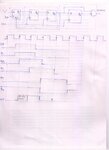hobbyiclearner
Full Member level 2
Hi,
I was going through Pedroni's FSM book and came across pulse detection circuit in Chap 2. As per fig 2.9 (b), if a pulse of greater length than one clock pulse (CP) is given to the ckt of fig 2.10, it is truncated to a length of exactly to a pulse of 1 CP duration which is available (as per the book) in between the input pulse edges. But as per my understanding, it should be available after 1 clock edge. Where am I going wrong pls.?
I am attaching the pdf of the relevant pages from the book and the timing diagram as per my understanding. Pls. see where I am going wrong.
Thanks and Regards,
Hobbyiclearner
 View attachment pedroni_chap_2.pdf
View attachment pedroni_chap_2.pdf
I was going through Pedroni's FSM book and came across pulse detection circuit in Chap 2. As per fig 2.9 (b), if a pulse of greater length than one clock pulse (CP) is given to the ckt of fig 2.10, it is truncated to a length of exactly to a pulse of 1 CP duration which is available (as per the book) in between the input pulse edges. But as per my understanding, it should be available after 1 clock edge. Where am I going wrong pls.?
I am attaching the pdf of the relevant pages from the book and the timing diagram as per my understanding. Pls. see where I am going wrong.
Thanks and Regards,
Hobbyiclearner
 View attachment pedroni_chap_2.pdf
View attachment pedroni_chap_2.pdf